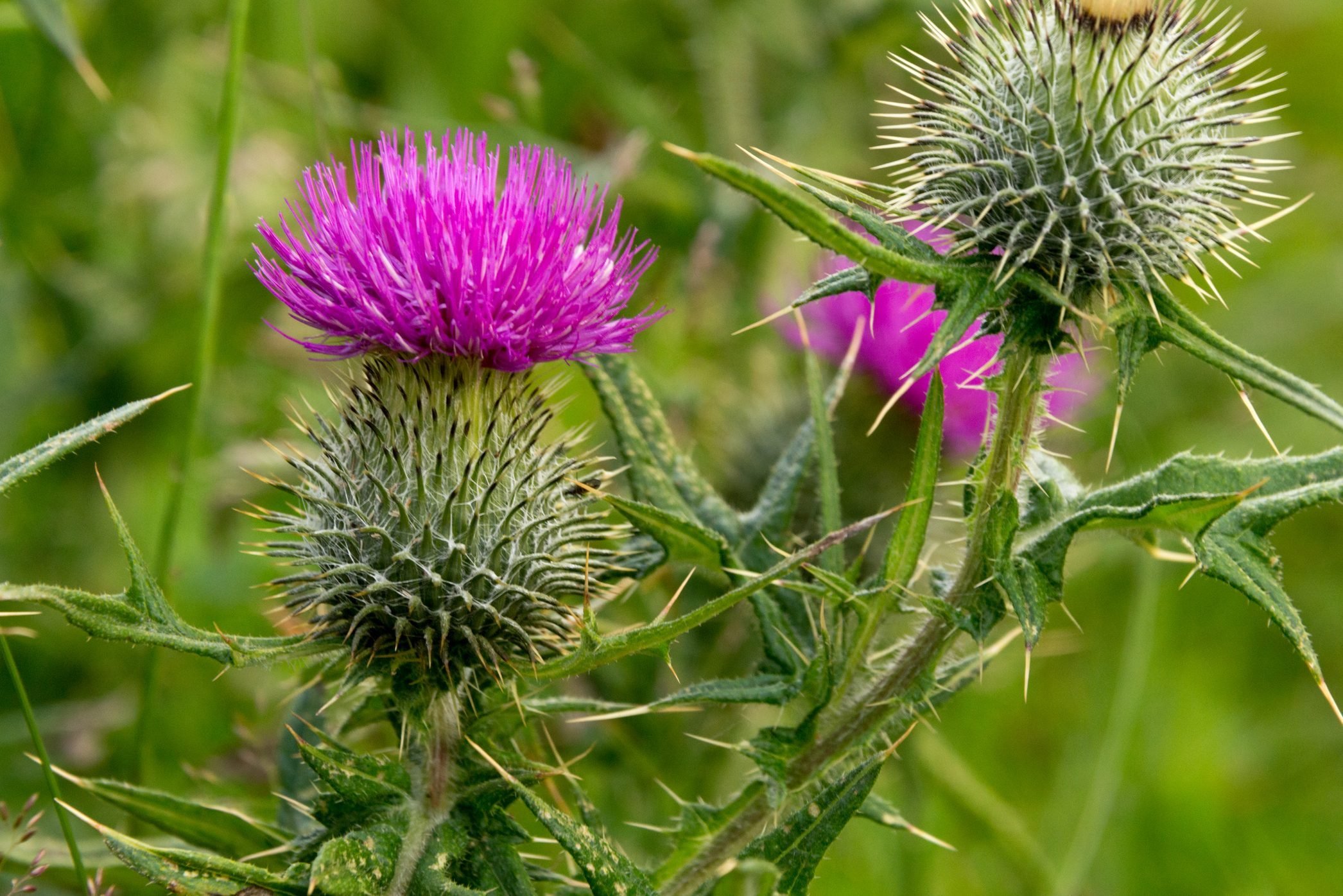Canada thistle can be a real pain, figuratively and literally. Also known as creeping thistle or cursed thistle, it can quickly wear out its welcome.

What Is Canada Thistle and How Do I Get Rid of It?

There are plenty of stubborn broadleaf weeds that test the patience of anyone working hard to maintain a lovely lawn, but none are more frustrating than Canada thistle. It’s like that last dinner party guest who won’t leave. Here is what you need to know about this tenacious weed.
On This Page
What Is Canada Thistle?
Canada thistle is an invasive perennial weed that almost always grows in patches. The stems and deeply lobed leaves are smooth to the touch, but those leaves come with prickly, painful spines around their margins.
This thorny troublemaker can grow up to five feet tall and produces a beautiful carafe-shaped purple flower in mid-summer or early fall. These flowers attract pollinators like bees and butterflies. That may be the Canada thistle’s only redeeming quality.
When Does Canada Thistle Grow?
Because it’s a perennial plant, Canada thistle never dies. It comes back every spring and, if left unchecked, can become a real nuisance.
Once firmly anchored in the ground, it can spread quickly via a robust root system. Vertical tap roots can penetrate up to six feet into the soil searching for water and nutrients. Sideways-growing rhizomes, 12 to 18 inches underground, can grow up to 12 feet per year, allowing Canada thistle to aggressively spread and propagate. That makes killing it difficult.
And as if that wasn’t enough, each of those beautiful purple flowers will distribute up to 5,000 seeds, effortlessly spread over your landscape by the wind. Seeds can stay viable in the soil for up to 20 years before germinating when conditions are right.
Canada thistle can be found in all 12 Canadian provinces and territories and 43 of 50 U.S. states, avoiding the South and Southeast for the most part. Canada thistle is considered a noxious weed in most states, meaning its control is required by law.
How to Prevent Canada Thistle
Weed prevention always begins with promoting a healthy lawn. Weeds are the result of a bad lawn, not the cause of it. Weeds exist because they’re opportunistic.
These are your best defenses against Canada thistle:
- Fertilize your lawn regularly, two to four times a year depending on where you live.
- Core aerate at least once a year to relieve soil compaction and stimulate grass growth.
- Do your best to keep your lawn well watered. This can be difficult without an in-ground sprinkler system, but do your best.
- If you detect thin areas in your lawn, overseed with a quality grass seed mixture.
How To Get Rid of Canada Thistle
The best ways to get rid of thistles don’t necessarily involve herbicides.
Each Canada thistle plant you see connects to a network of underground rhizomes, creating an elaborate web of what appears to be individual plants. Pulling up individual weeds can actually make things worse. When you pull it, it breaks, and the rhizome it’s connected to can sprout two more plants to replace the one you just pulled!
It takes a long-term commitment to completely remove them from your lawn or landscape. Here are some suggestions:
- Start by snipping the plants off at ground level with household scissors. Yes, they will grow back. But every time you cut one off, you reduce the thistle’s ability to produce food, slowly weakening the entire patch. If you keep cutting them off, the plants will eventually succumb.
- If you’d rather pull the weeds, use a weeding tool like Grampa’s Weeder to selectively remove individual plants.
- If neither option is practical, spraying with a premium herbicide will yield good results. Use a product that contains triclopyr or carfentrazone. Herbicides like Monetrey Turflon Ester or Gordon’s SpeedZone are heavy hitters that will suppress Canada thistles and other stubborn broadleaf weeds.
- If you’d rather take an organic approach, try Bonide Weed Beater Fe. Also, Natural Armor Weed and Grass Killer is a non-selective, glyphosate-free alternative that will “burn off” the top growth but not the roots. That’s okay. Think of this as “chemically cutting” them off rather than using scissors. Organic weed killers often take multiple applications to be effective and can harm your lawn if applied incorrectly.
How To Keep Canada Thistle from Coming Back
- Keep your lawn thick and healthy by fertilizing, watering and overseeding.
- Keep your mower set at three inches or higher. This will shade the soil surface and help suffocate any weeds that may try to encroach.
- Scout your lawn regularly. When you see a Canada thistle plant, nip it at a young age.
Is Canada Thistle Safe?
Canada thistle is not a safety concern. However, it’s no fun to step on with bare feet.
If you have kids who like to roll around in the grass, you’ll hear about it if they find a thistle! Pets and wildlife shy away from thistle plants because of their prickly natural defense mechanism.
If one of those thorny barbs ends up in your hand or foot, simply remove it with tweezers, like you would a sliver. They contain no harmful toxins.




















